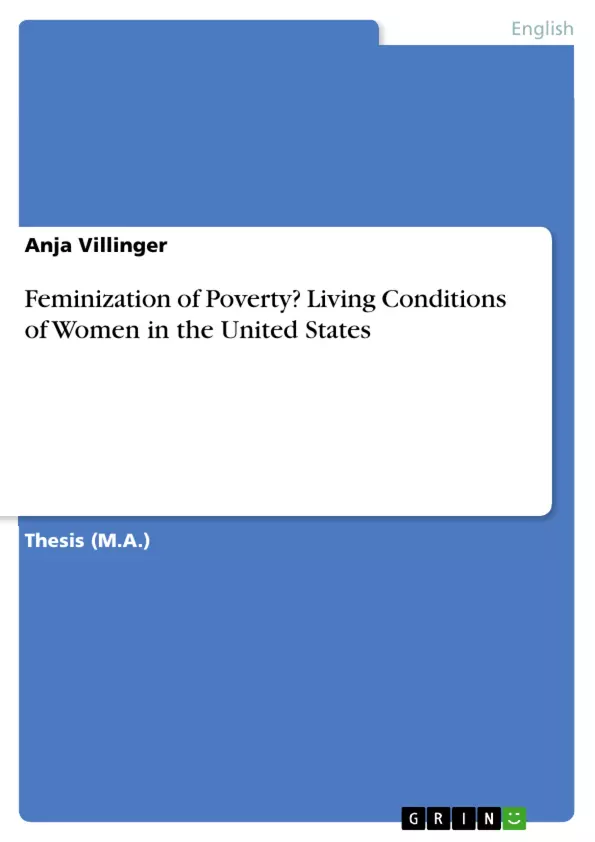Introduction
No novelty in the United States struck me more vividly during my stay there than the equality of conditions.
(Alexis de Tocqueville)
With this statement, the European aristocrat Alexis de Tocqueville, who came to the U.S. in 1831, took up one of America’s well-known founding myths: that of equality. The view of America as the land of unlimited opportunities and equal chances, where everybody can try his luck and pursue his own happiness, is still widespread today – inside as well as outside of America.
The paradox with this myth is that today, the USA is the Western nation with the greatest percentage of the world’s rich and with the widest gap between rich and poor. A closer look into the statistics reveals that certain groups and minorities seem to be more disadvantaged than others since they are stronger represented among the poor. This fact seriously calls into question the image of America as the country of equal living conditions.
Nevertheless, most Americans strongly trust in their equal opportunities for economic advancement: 72% believe in their own chance to raise their living standard – a share that is disproportionately higher than in other countries. In Germany, for example, only 41% of the interviewees estimate their opportunities in such an optimistic way (cf. Rode 1992: 192).
This picture of the United States is also often predominant in the minds of adult learners of English as a foreign language. My intention with this paper is to show them the “other America”, that one far away from the rags-to-riches stories told in numerous Hollywood films. The other America shows high and persistent poverty rates for certain population groups and minorities. During my preliminary reading, I repeatedly came across the term Feminization of Poverty. I wondered what this term exactly embraces, how this phenomenon can emerge in one of the richest industrialized Western nations and why the U.S. government is not able– or not willing - to counter effectively to that phenomenon. As, in my opinion, the issue of the Feminization of Poverty in the United States needs further explanation to understand its complex nature and with it, some particularities of the American society, I decided to dedicate my thesis to poor women and their living conditions in the United States.
Table of Contents
- I. Introduction
- II. Teacher's Handbook
- 1 Trends in Poverty Rates
- 1.1 General Facts about Poverty
- 1.2 Group Specific Poverty Rates
- 2 Defining the Terms
- 2.1 Poverty
- 2.2 Taking the Measure
- 2.3 The Feminization of Poverty
- 3 The Feminization of Poverty: Its Nature and its Causes
- 3.1 Changes in Economy
- 3.2 Changes in Social Structures
- 3.3 "Color Line” Black vs. White - Some Explanations
- 3.4 Reviewing the Feminization of Poverty
- 4 The Role of the Welfare State
- 4.1 Single-Mother Families and the Social Welfare Response
- 4.2 The United States - A Welfare State Laggard
- 5 Conclusion
- 1 Trends in Poverty Rates
- III. A Teaching Model
- 6 Preface
- 6.1 Target Group
- 6.2 Educational Goals
- 7 A Historical Approach
- 6 Preface
Objectives and Key Themes
This thesis investigates the feminization of poverty in the United States, examining its nature, causes, and the role of the welfare state in addressing this issue. The study explores the increasing prevalence of poverty among women, particularly single mothers, in the context of changing economic and social structures.
- Trends in poverty rates and their impact on women
- The definition and measurement of poverty, including the concept of the feminization of poverty
- The role of economic and social factors in contributing to the feminization of poverty
- The response of the welfare state to single-mother families and the limitations of the American welfare system
- The historical development of welfare policies in the United States
Chapter Summaries
- I. Introduction: Provides an overview of the thesis's objectives, key themes, and research methodology.
- II. Teacher's Handbook:
- Chapter 1: Trends in Poverty Rates: This chapter analyzes poverty rates in the United States, focusing on general trends and specific groups, such as women and children.
- Chapter 2: Defining the Terms: This chapter defines key terms, such as poverty and the feminization of poverty, and discusses different approaches to measuring poverty.
- Chapter 3: The Feminization of Poverty: Its Nature and its Causes: This chapter examines the nature and causes of the feminization of poverty, exploring economic factors, social structures, and the role of racial disparities.
- Chapter 4: The Role of the Welfare State: This chapter discusses the response of the welfare state to the challenges faced by single-mother families, analyzing the evolution of welfare policies and the limitations of the American welfare system.
- III. A Teaching Model:
- Chapter 6: Preface: This chapter outlines the target group and educational goals for the proposed teaching model.
- Chapter 7: A Historical Approach: This chapter focuses on developing a historical approach to teaching the subject of the feminization of poverty.
Keywords
The thesis focuses on the feminization of poverty in the United States, exploring key concepts such as poverty rates, single-mother families, social welfare policies, economic inequality, and racial disparities. The analysis draws on research related to the welfare state, changing social structures, and the impact of economic trends on vulnerable populations.
- Arbeit zitieren
- M.A. Anja Villinger (Autor:in), 2005, Feminization of Poverty? Living Conditions of Women in the United States, München, GRIN Verlag, https://www.grin.com/document/51540



